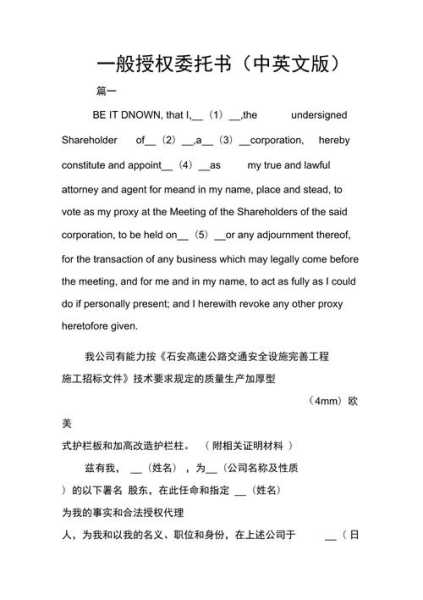This guide provides a comprehensive understanding of Personal Power of Attorney documents in English. It covers the basics, types, and legal implications of these documents, ensuring readers are well-informed about granting someone legal authority to act on their behalf.
In the realm of legal documents, a personal power of attorney (POA) stands as a crucial instrument that grants someone the authority to act on behalf of another person. This document is particularly important in situations where an individual, known as the principal, is unable to manage their own affairs due to illness, disability, or simply because they are out of the country. This article delves into the intricacies of a personal power of attorney document, providing a comprehensive guide in English for those seeking to understand its purpose, structure, and legal implications.

What is a Personal Power of Attorney?
A personal power of attorney is a legal document that authorizes one person, known as the attorney-in-fact or agent, to act on behalf of another person, the principal. The agent is granted specific powers to make decisions and perform certain acts on the principal's behalf, which can range from handling financial matters to making medical decisions.
Types of Personal Power of Attorney
There are several types of personal power of attorney, each with its own scope and limitations:
1、General Power of Attorney: This type of POA grants the agent broad authority to act on the principal's behalf in all matters unless specifically restricted.
2、Durable Power of Attorney: A durable POA remains in effect even if the principal becomes incapacitated. It is often used for long-term care or when the principal is traveling.
3、Limited Power of Attorney: This POA grants the agent authority to act only in specific situations or for a limited period.
4、Springing Power of Attorney: This POA becomes effective only when the principal becomes incapacitated, as determined by a doctor or other specified individual.
Key Components of a Personal Power of Attorney
To create a legally binding personal power of attorney, the document must include the following components:
1、Identification of the Principal and Agent: The document must clearly identify the principal and the agent, including full legal names and addresses.
2、Grant of Authority: The specific powers granted to the agent should be clearly outlined. This can include financial management, real estate transactions, medical decisions, and more.
3、Duration: The POA should specify the duration of the agent's authority, whether it is a limited period or indefinite.
4、Revocation Clause: The document should include a clause that allows the principal to revoke the POA at any time.
5、Notarization: In many jurisdictions, a POA must be notarized to be legally valid.
How to Create a Personal Power of Attorney
Creating a personal power of attorney is a serious matter that should not be taken lightly. Here are the general steps to create a POA:
1、Consult a Lawyer: It is advisable to consult with a legal professional to ensure that the POA is properly drafted and complies with local laws.
2、Choose an Agent: Select someone you trust to act as your agent. Consider their reliability, honesty, and ability to handle the responsibilities.
3、Draft the Document: Use a template or consult with a lawyer to draft the POA. Ensure that all necessary information is included and that the document is clear and concise.
4、Sign the Document: Both the principal and the agent must sign the document in the presence of a notary public or other witnesses, as required by law.
5、Distribute Copies: Provide copies of the POA to the agent, any financial institutions or healthcare providers that may need to recognize the document, and anyone else who may be affected by the POA.
Legal Implications and Considerations
It is crucial to understand the legal implications of a personal power of attorney:
1、Agent's Responsibility: The agent must act in the best interests of the principal and must not use the authority for personal gain.
2、Monitoring: The principal should monitor the agent's actions and have the right to revoke the POA at any time.
3、Termination: The POA terminates upon the death of the principal or if the principal becomes incapacitated and the POA does not specify that it remains in effect.
4、Disputes: In case of disputes, the document should include a clause specifying how disputes will be resolved.
In conclusion, a personal power of attorney is a vital legal document that can provide peace of mind and ensure that your affairs are managed appropriately in your absence or incapacity. By understanding its purpose, structure, and legal implications, you can make informed decisions and create a document that fulfills your specific needs. Always seek legal advice when drafting a POA to ensure its validity and effectiveness.
相关阅读:
1、Mastering the Pronunciation of Power of Attorney: Your Ultimate English Guide
3、Ultimate English Travel Power of Attorney Template: Simplify Your Secure Travel Planning
4、Understanding the Importance, Format, and Precautions of English Power of Attorney Documents
5、Standard English Sample Authorization and Power of Attorney Letter Template
Mastering the Updated Personal Power of Attorney Documents: Your Ultimate English Guide
Mastering Personal Power of Attorney Documents: Your Ultimate English Guide
Mastering Personal Power of Attorney Documents: Your Ultimate English Guide
Mastering Personal Power of Attorney Documents: Your Ultimate English Guide
Mastering Personal Power of Attorney Documents: Your Ultimate English Guide
Mastering Personal Power of Attorney Documents: Your Essential Guide to Drafting and Understanding
Mastering Personal Power of Attorney: Your Ultimate English Document Crafting Guide











